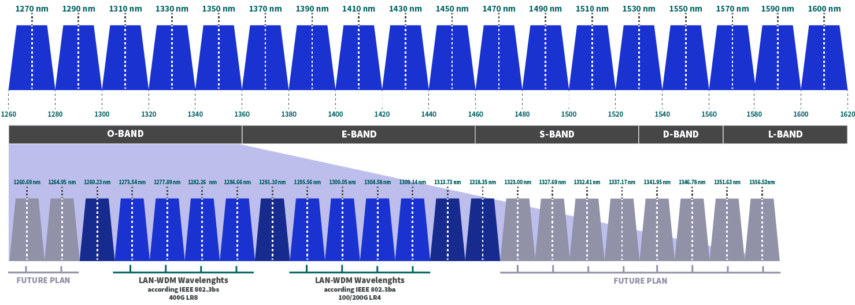The fronthaul adopts the optical fiber direct drive solution, which can not only meet the performance requirements of the fronthaul interface, but also relatively simple in construction and maintenance management. NGOF proposed a 25Gbps BiDi technical solution as early as early 2018, and it has now achieved large-scale commercial use. On the one hand, the single-fiber bidirectional transmission technology can save about 50% of optical fiber resources, and on the other hand, it also ensures the consistency of uplink and downlink signal delays, which is conducive to meeting the high-precision synchronization requirements of 5G services.
However, with the in-depth development of 5G, especially in the co-construction and sharing scenario of China Telecom and China Unicom, even if the BiDi solution is adopted, a single sharing station still needs 6 optical fibers, which will still cause huge pressure on the access optical cable network. To this end, wavelength division multiplexing (WDM) technology has become an important means of 5G fronthaul. It enables multiple CPRI or eCPRI interfaces to share fiber resources through different wavelengths, so that one (or a pair) fiber can solve one station or multiple The 5G fronthaul demand of the station greatly improves the fiber utilization rate. According to the different channel spacing, xWDM technical solutions can be divided into CWDM technical solutions, LWDM technical solutions, and DWDM technical solutions.
CWDM Solution

Coarse wavelength division (hereinafter referred to as CWDM) scheme adopts coarse wavelength division multiplexing technology, the wavelength refers to the ITU-T G.694.2 standard, the channel spacing is 20 nm, the CWDM color light module is installed on the AAU/RRU and BBU/DU, and the The CWDM combiner and demultiplexer completes the WDM function, and provides multiple connections from AAU/RRU to BBU/DU using a pair or one optical fiber.
At present, the fronthaul CWDM system mainly includes 6-wave systems and 12-wave systems. 6-wave system can be used for 3-channel S111 station with 100MHz spectrum bandwidth, preferably 1271/1291/1311/1331/1351/1371 nm, the first 4 waves currently have DML (direct modulation laser) + PIN (photodiode) low-cost solution, but When using DML for 1351/1371 nm, the cost of dispersion is relatively large (2 to 2.5 dB higher than the first 4 waves), and APD (avalanche diode) needs to be used for dispersion compensation to ensure the same link power budget. When 6 channels (12 wavelengths) are required, due to the high cost of DML dispersion, EML (electro-absorption modulated laser) must be used. In order to avoid the “water peak” of G.652 fiber, the wavelength is preferably 1471/1491/1511/1531/1551 /1571 nm. However, due to technical limitations, these 6 wavelengths can only support 10 Gbps rate, and it is difficult to further expand to more wavelengths. Therefore, the 12-wave CWDM system is generally used for 4G and 5G co-located stations.
The cost of the CWDM solution is low, but there are also some problems:
(1) Due to the use of fixed wavelengths, there are problems in the identification of wavelengths in network construction and maintenance, the number of spare parts is large, and the management is inconvenient;
(2) Limited by the long Due to the dispersion cost of excessive wavelength and the performance of the low-cost DML+PIN solution, the passive CWDM solution reduces the maintenance margin to 2 dB, and the maintenance pressure is relatively large;
(3) Due to the low-cost and no temperature-controlled structure, the 5G fronthaul scenario faces a low temperature area
(4) Passive CWDM optical modules do not have OAM capabilities for the time being, and network management and control capabilities are limited.
LWDM Solution

LAN-WDM technology (LWDM for short, or thin wavelength division multiplexing), in line with the IEEE 802.3BA standard, divides the O-band spectrum according to the 800 GHz (about 4.4 nm) channel spacing, with a total of 8 standard wavelengths, respectively 1273.54 nm ~ 1309.14 nm. For the 12-wave system requirements, 4 wavelengths are expanded, and the initial wavelength range is 1269.3 nm to 1318.35 nm.
The technical advantage of LWDM lies in the sharing of the industrial chain, which can share the 400G LR8 industrial chain (1273.54 nm ~ 1286.66 nm) and the 100G LR4 industrial chain (1295.56 ~ 1309.14 nm), and reuse the CWDM industrial chain. The operating wavelength of the 25 Gbps channel is located near the zero dispersion point, the dispersion cost is small (<1dB), and the scalability is good. The device cost of each channel is also lower, and all 12 25 Gbps channels and 12 extended 10 Gbps channels can meet the 10 km transmission requirement through the low-cost method of DML+PIN+TEC temperature control, and guarantee not less than 3 dB. Maintenance redundancy; if the 10G extended channel adopts DML+APD combination, it can meet the transmission distance requirement of 15 km or even 20 km. Due to the small wavelength interval of the 25 Gbps channel, the LWDM scheme requires relatively strict wavelength control, so the temperature control module (TEC) is generally used. LWDM can implement simple OAM management by using the top-adjustment method, but due to the fixed wavelength method, there are too many types of optical module spare parts.
DWDM Solution

The solution adopts DWDM technology with 100GHz channel spacing and single-fiber bidirectional structure. The wavelength adjustable range includes 6 waves, 12 waves, 20 waves and 40 waves, etc. 10G and 25G share a wavelength pool. Large capacity, and can make full use of the existing mature DWDM industry chain. The optical module of the DWDM solution uses the EML+PIN+TEC solution and supports wavelength tunability. Although EML increases the cost, the dimmable optical module greatly reduces the type and quantity of spare parts and is easy to maintain. At the same time, because the DWDM scheme uses the 1550 nm wavelength with low attenuation, the maintenance margin is high, up to 3 dB. In order to solve the cost problem, fixed wavelength DWDM solutions have also been proposed in the industry. However, there are many types of optical modules (click here) in this solution, and its network construction and operation and maintenance are relatively complex. Due to the large system capacity and high fiber utilization, it is currently deployed in overseas operators such as Europe and the United States.







